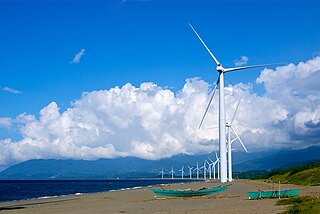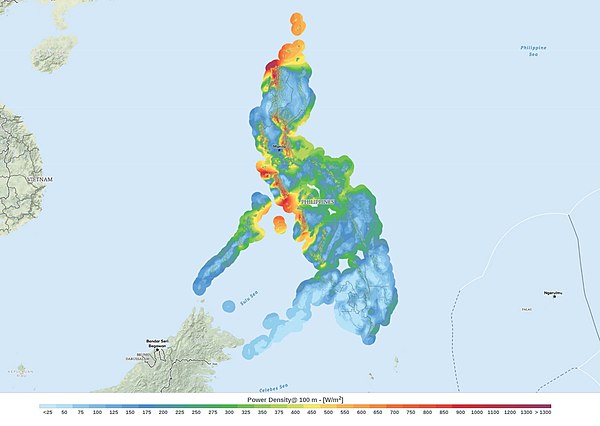
Ilocos Norte, officially the Province of Ilocos Norte, is a province of the Philippines located in the Ilocos Region. Its capital is Laoag City, located in the northwest corner of Luzon Island, bordering Cagayan and Apayao to the east, and Abra to the southeast, and Ilocos Sur to the southwest. Ilocos Norte faces the West Philippine Sea to the west and the Luzon Strait to the north.

A wind farm or wind park, also called a wind power station or wind power plant, is a group of wind turbines in the same location used to produce electricity. Wind farms vary in size from a small number of turbines to several hundred wind turbines covering an extensive area. Wind farms can be either onshore or offshore.

Bangui, officially the Municipality of Bangui, is a 4th class municipality in the province of Ilocos Norte, Philippines. According to the 2020 census, it has a population of 15,019 people.

Iberdrola is a Spanish multinational electric utility company based in Bilbao, Spain. Iberdrola has a workforce of around 40,000 employees serving around 30 million customers. Subsidiaries include Scottish Power and a significant part of Avangrid, amongst others. As of 2023, the largest shareholder of the company is the Qatar Investment Authority, with BlackRock and Norges Bank also holding significant interests.

The United Kingdom is the best location for wind power in Europe and one of the best in the world. The combination of long coastline, shallow water and strong winds make offshore wind unusually effective.

In 2021 France reached a total of 18,676 megawatts (MW) installed wind power capacity placing France at that time as the world's seventh largest wind power nation by installed capacity, behind the United Kingdom and Brazil and ahead of Canada and Italy. According to the IEA the yearly wind production was 20.2 TWh in 2015, representing almost 23% of the 88.4 TWh from renewable sources in France during that year. Wind provided 4.3% of the country's electricity demand in 2015.
Goldwind Science & Technology Co., Ltd., commonly known as Goldwind, is a Chinese multinational wind turbine manufacturer headquartered in Beijing, China. Goldwind was a state-owned enterprise before 2007, with largest shareholders including Hexie Health Insurance, China Three Gorges Renewables Group, and the National Social Security Fund, state-controlled corporations holding almost 40% shares. Its founder, Wu Gang, is a Communist Party member and had a seat in the 12th National People's Congress.

As of November 2023, wind power in the Netherlands has an installed capacity of 11,602 MW, 40.9% of which is based offshore. In 2022, the wind turbines provided the country with 18.37% of its electricity demand during the year. Windmills have historically played a major part in the Netherlands by providing an alternative to water driven mills.

The Bangui Wind Farm is a wind farm in Bangui, Ilocos Norte, Philippines. The wind farm uses 20 units of 70-meter (230 ft) high Vestas V82 1.65 MW wind turbines, arranged in a single row stretching along a 9-kilometer (5.6 mi) shoreline of Bangui Bay, facing the South China Sea.

In Japan's electricity sector, wind power generates a small proportion of the country's electricity. It has been estimated that Japan has the potential for 144 gigawatts (GW) for onshore wind and 608 GW of offshore wind capacity. As of 2023, the country had a total installed capacity of 5.2 GW.
Energy Development Corporation is the largest producer of geothermal energy in the Philippines and the second largest in the world. It is involved in alternative energy projects, including geothermal, hydroelectric and wind energy projects. The company was formerly owned by the Philippine National Oil Company, a state corporation owned by the Republic of the Philippines engaged in the exploration of resources, production of energy and distribution of power supply to smaller electricity distributor. EDC was privatized and acquired by the Lopez Group as part of its energy and power supply utility business units.

Burgos Wind Farm is a wind farm in Burgos, Ilocos Norte, Philippines. It is the second wind farm built in the province of Ilocos Norte and the largest project of its kind in the Philippines. The estimated cost for the construction of the wind farm was US$450 million. The wind farm was commissioned on November 9, 2014, and upon its completion it became the largest wind farm in the country and in Southeast Asia, covering 600 hectares and three barangays of Burgos, namely Saoit, Poblacion, and Nagsurot. The project was the first one to be nominated by the Department of Energy as eligible for the department's feed-in tariff (FIT) scheme.
The Wind Energy Power System (WEPS) is a wind farm project located near Puerto Galera, in the Philippine province of Mindoro Oriental. Once completed the project will generate an estimated 48MW of electricity.

Renewable energy in Taiwan contributed to 8.7% of national electricity generation as of end of 2013. The total installed capacity of renewable energy in Taiwan by the end of 2013 was 3.76 GW.

Caparispisan Wind Farm, also known as the North Luzon Renewables Wind Farm, is a wind farm in Pagudpud, Ilocos Norte, Philippines. The wind farm was a joint venture of AC Energy Holdings, the Philippine Alliance for Infrastructure and the UPC Philippines Wind Holdco. The wind farm project amounted to $220 million.

The East Anglia Array is a proposed series of offshore wind farms located around 30 miles off the east coast of East Anglia, in the North Sea, England. It has begun with the currently operational East Anglia ONE, that has been developed in partnership by ScottishPower Renewables and Vattenfall. Up to six individual projects could be set up in the area with a maximum capacity of up to 7.2 GW. The first project, East Anglia ONE at 714 MW, received planning consent in June 2014 and contracts in April 2016. Offshore construction began in 2018 and the project was commissioned in July 2020. It is expected to cost £2.5 billion.

The "Pililla, Rizal" Wind Energy Service Contract granted to Alternergy Philippine Holdings Corporation (APHC) covers an area of 4,515 hectares under Department of Energy WESC NO. 2009-09-018. This Wind Energy Service Contract (WESC) has two phases, Pililla Wind Power Project under WESC NO. 2009-09-018-AF1 and the Mt. Sembrano Wind Power Project under WESC NO. 2009-09-018-AP2.
In 2013, renewable energy provided 26.44% of the total electricity in the Philippines and 19,903 gigawatt-hours (GWh) of electrical energy out of a total demand of 75,266 gigawatt-hours. The Philippines is a net importer of fossil fuels. For the sake of energy security, there is momentum to develop renewable energy sources. The types available include hydropower, geothermal power, wind power, solar power and biomass power. The government of the Philippines has legislated a number of policies in order to increase the use of renewable energy by the country.

Wind power is a major industry in Taiwan. Taiwan has abundant wind resources however a lack of space on land means that most major developments are offshore. As of February 2020, there were 361 installed onshore turbines and 22 offshore turbines in operation with the total installed capacity of 845.2 MW.
ACEN Corporation, formerly AC Energy, is the energy firm under the Ayala Group. The company has over 4,000 MW of attributable capacity in the Philippines, Vietnam, Indonesia, India, and Australia, with a renewable share of 98% which is among the highest in the region.















